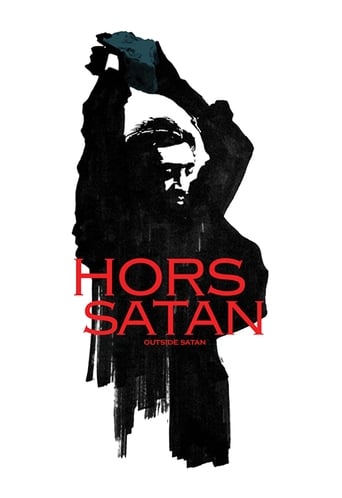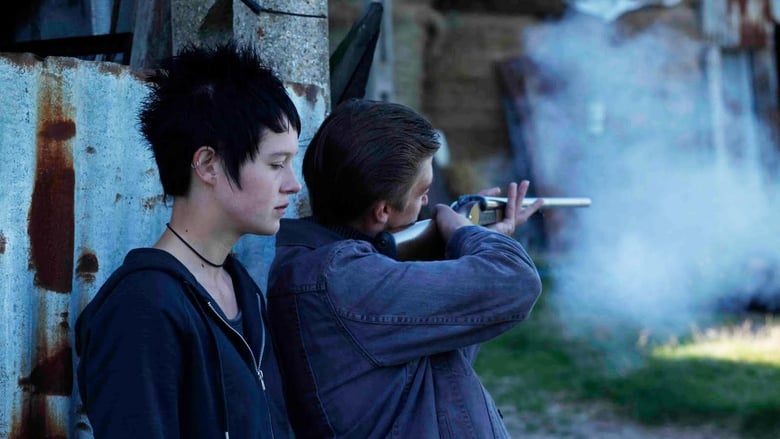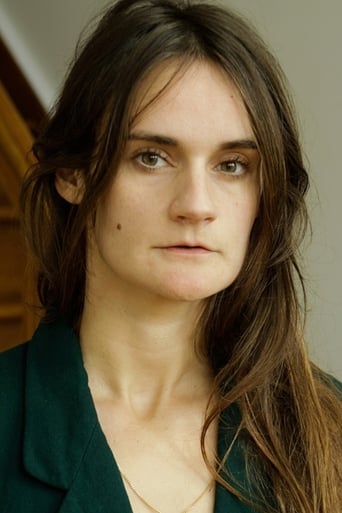

Outside Satan (2011)
Along the Côte d'Opale, near a hamlet, with its dunes and marshes, lives a mysterious wanderer from nowhere who struggles along, poaches, prays and builds fires...
Watch Trailer
Cast


Reviews
Best movie of this year hands down!
Wonderful character development!
Very well executed
Sadly Over-hyped
Much has been written about the role of the environment in this film. Rarely can natural (and outwardly naturalistic) settings have been so crucial to the action and ambiance of a movie. Manhattan springs to mind as another work in which the setting functions almost a key character (bet you didn't expect to see a comparison with Woody Allen in this review).The director forces the audience to see something explicitly religious (and in the case of the guy, Christ-like) in the two leads, by depicting overt religious symbolism in their actions and gestures. There is nothing simplistic in this portrayal, however: the characters' actions are always underpinned by a faint whiff of shamanism, nature-worship or even downright satanism, bringing a delicious - and potentially controversial - complexity to the film.The action appears to take place outside the modern world, or at the very least parallel with it (I referred to the "medieval" atmosphere evoked by Dumont's work in another review, and Hors Satan is a little like that too). In this strange parallel world, the police, for example, don't act as expected - in fact, nobody acts as expected. Despite the slow pace, however, I never got the feeling that the story was not moving forward (and I'm baffled by the failure of one reviewer to identify any storyline at all).Much of the tension lies in the audience's fear - of what the characters will do to one another and to the landscape, of what the consequences of their actions may or may not be, and of what the movie's ultimate outcome will be. It is this elemental drama that drives the film forward - in a slow-burn movie in which death accounts for an amazingly high proportion of the "action" that actually does take place, life and death are in the balance in an extremely immediate and terrifying way. The central Christ-like character can be violent, and his actions incomprehensible, perhaps reminding us that Christ was himself capable of unexpected violence (for example when throwing the money-lenders out of the temple). Although of course the director also leads us towards a view of the lead character as a Satanic figure, particularly in one almost unwatchably horrible scene.Perhaps the central achievement of this film - by an apparently atheist director, remember - is to have created a powerful drama with a complex Christ-like figure who reflects the mysticality and profound unknowability and yet the intangible magnetism of the original biblical Christ, while incorporating elements of the satanic into the character too. A difficult comparison for Christians to swallow, though.
This strange film is set on the northern French coast around Calais.A vagabond(David Dewaele)lives in the wilds of nature,with a small fire to keep him warm.His companion,a teenage dark-haired virginal goth(Alexandra Lematre), walks with him everywhere. They are both lost in a mirage of naturalism,supposedly beyond both good and evil,'hors Satan'. There is no back-story.The man gives to people what they want:to the young girl he is a protector,refusing to have sex with her and killing the guard who harasses her,he's also killed her step-father for abusing her at the start of the film.Police make enquiries about the murders. The goth lives with her mother.To a hitch-hiker he brings sexual bliss,so she is frothing at the mouth. For the mother whose daughter is possessed he drives out the demons by raping the possessed young girl.He moves around his territory like a hunter-gatherer, but the territory is spiritual and he seems to commune with nature,kneeling,taking in the land and sky.He can knock at any door and get a bite to eat,as the people who live around here trust him.His young companion gets raped and dies and he mysteriously takes her body out into the landscape and lays it in a certain way and leaves it.The strange ritual is a form of resurrection.He is a holy fool or shaman,a phalli-centric worshipper of nature.What do we make of Dumont's purpose here? He has taken the character who was marginal in his last film,Hadewijch, but was pivotal as the natural man in saving the central character from committing suicide, and he's made him the central character in this film,which has no music; you hear only the sounds of nature,breathing,walking,the wind, leaves, water and birds.The characters have no names.This is a new world of primitive,mythological fantasy.The objective lens pans the countryside, dunes,trees,marshes, hills,streams,capturing sunrise,magic-hour,the long shots are slow,panoramic, the dialogue minimal,impregnating us with the image like a Poussin or Constable painting.The character can be seen as both evil and good,being one and the same thing.The characters are half-way between symbol and reality.Dumont is the atheist moving towards Bressonian subject matter(The Devil, Probably),bringing in religious themes. In this society we seem free of the ills of capitalism and modern technology,in marginal space,a magical zone,outside the normal rules that would apply in urban life in cities and towns.There is a serial killer rapist in the vicinity,who has a dog.When the police capture him,the natural wanderer takes his dog and walks on to his next location.This ends a trilogy of films made on spiritual themes. Absolutely astonishing.
as much as i love artistic and avant-garde movies (many of them), i just don't think this movie really has anything.scenes are way too long. (horrible editing) i understand that some scenes need to be long for establishing reason or emotional reason or story point. but scenes in general are far too long without much reason to the story. no one needs to see the same scenery for 5 minutes. and we don't need to see a character walking around at the same background for 5 minutes. very unnecessary. and it leads to a lack of concentration.acting is quite bad...? i am not really sure if the character (the main guy) has to look that awkward all the time... if that was the actual direction from the director, then he was very nice. but i don't know why it was directed that way, if that was true. he seems to have the exact same face and eyes all the time, which doesn't really give me anything...is there a story? i just can't seem to find any story. someone wrote a review that this is for open interpretation. well... it is like i am looking at a circle on a canvas and trying to explain that this is a modern art. i think this movie is just bad, trying (somewhat) to be artistic. i do love modern art and many conceptual things. but this is not a surreal nor anything else. certainly not a genre in itself.i would give some credit for cinematography. that is the only thing that i like. but not much anyway...anyway, don't watch this movie. there are many other good movies.
We could extract many elements out of this movie, and focusing only on one philosophical aspect/thought sequence right now, sequence with certain 'ethico-religious' consequences, the following comes to our view: one thing which is recurring and like a repeating cycle overwriting itself, a "constant" through the film, is the perpetual and persistent "gaze" of the main protagonist.The gaze somehow in its element of "gaze as such"/the pure gaze, transcends the limits of "particularity" and connects itself correspondingly with the vast and vacant environment, the mountains or trees or the sun on the horizon etc. Those visual fields are the approximation to this pure gaze, which just gazes, absorbs the various elements in itself, enveloping the whole environment and making it extinct in the "act of the gaze", somehow dislocating itself from/through the "particular" to connect itself with the "universal", like the empty canvas which contains all the colors and contours of the picture; the gaze remains like this empty canvas, which is somehow beyond "good and evil", in a sense, it is the indifferent element, which takes both good and evil as the same and interchangeable - the pure gaze appears as if untouched by different particularities or the content which it will process along the way. Could this "hors-satan-gaze" be the pure gaze of the (pure) consciousness, the spiritual tradition is talking about? In various religious traditions there are divine madmen, who appear crazy, to whom the moral standards don't apply anymore, to whom the codes of normality, the rigid distinction between good and evil is just useless and a sign of fear and conformity. Is the main protagonist of the movie this kind of divine madman? Could be. Is his perseverance to do what he has to do (without obvious and self-evident reasons behind his actions), at the specific junction of the action/happenings that take place, a certain "death drive", drive that goes beyond life, beyond the safe and life-preserving functions; does that make him diabolical for that reason? Could we link his character, for example, to the characters like Bobby Peru (played by Willem Dafoe) from David Lynch's "Wild at heart" or maybe crazy Anton (played by Javier Bardem), the Coen Brothers movie "No Country for Old Men"? In some sense all those characters appear stronger than the Life itself, driven by a sort of pure Death drive, not minding the consequences, like strange impersonations of the apocalyptic figures that destroy what needs to be destroyed along the way (by some unfathomable self-will), but at the same time confront us with radical truths which remain hidden to us, or better, the truths "we don't want to know anything about them". Are they divine figures that confront us with our own devils? It is to be answered individually. What is more diabolical, the action itself, good or bad, or the "gaze as such" which is witnessing both? In a sense, this gaze remains intact and 'pure' by the good or bad input; it accepts them both. Isn't this the perversity of the gaze itself, to be indifferent, to take upon itself whatever it comes, without any distinction? If we say that one person is good or bad, we say this according to the standards of what is good and bad action; action needs to be done so that we can retroactively evaluate if the person is 'good' or 'bad'; only when the action is done we can say, that this person has decided (though it can/could be theoretically 'predetermined' by the causal chain events) to act according to his 'eternal' nature, which shows its "eternal character", only through particular actions that someone takes upon through the course of life.In the instances of "Hors Satan" characters, it appears as if they evade this logic and are the subjects which freely rearrange the parameters of life, as if by a bizarre strike of "deus ex machina" intervention, and thus change completely the scenery and current events by dropping down the unbearable truth of confronting us with our worst nightmares and casual fears. They are certainly not the universal remedy, but they bring a certain perspective which pushes the ordinary reality to its borders, forcing us to rethink the thin lines between good and evil.


